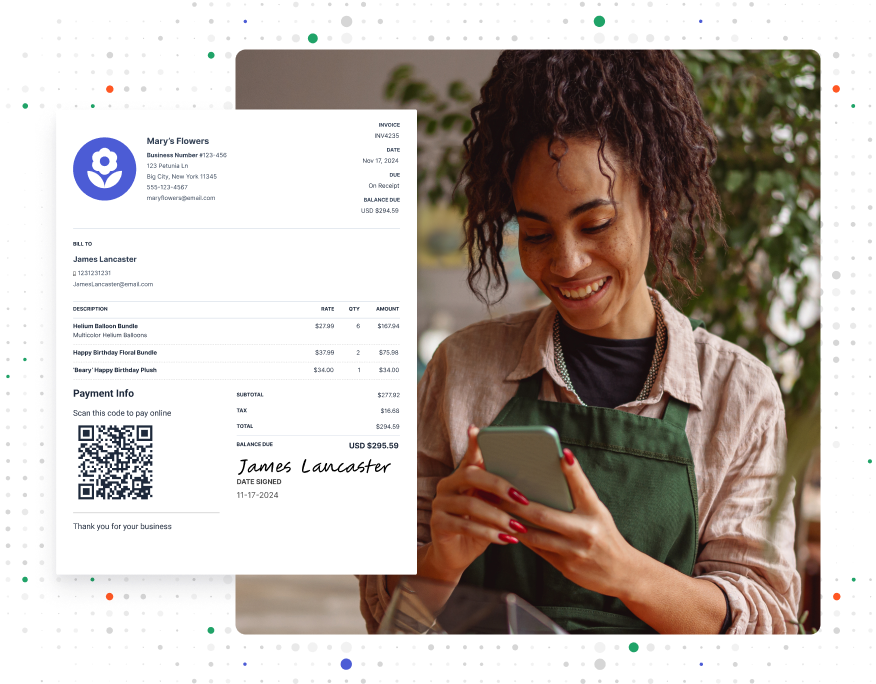The Ultimate Guide to Subscription Billing Setup for Independent Contractors

Subscription services are increasingly popular. Today, the average consumer spends $219 per month on subscriptions.
This figure is expected to grow, too. Subscription revenue will reach a staggering $996 billion by 2028. To put that in perspective, the 2024 value is about $593 billion.
As a small business owner, it’s your job to keep up with new trends and shifting customer expectations. And that’s why now’s the time to adopt subscription billing.
How? This guide will show you.
First, we’ll explain what subscription billing is and how it benefits independent contractors. Then, we’ll give you step-by-step instructions on getting set up.
We’ll finish with a couple of quick tips you can use to get started today.
There’s a big opportunity to delight your customers and boost your cash flow. Here’s what you need to know.
What Is Subscription Billing?
Subscription billing is a great option for ongoing services or projects. It works like this:
- Your client is billed a certain amount on a set day each week, month, or other time period.
- The billing happens automatically—no manual work needed.
- The automatic payments continue until the client no longer needs your services.
You’re probably already familiar with this payment model. Maybe you have a subscription or two—think Netflix or Spotify—that bills you automatically.
Subscription billing for independent contractors is much the same. It’s quick and convenient and almost guarantees on-time payments.
How Subscription Billing Can Benefit Independent Contractors

Why should you consider adopting a subscription payment model for freelance work? Because how you get paid matters. It has a huge impact on how your business functions.
It even shapes the client experience—easier payments mean happier clients. Happier clients shout about your business from the rooftops, which means more reviews and referrals.
Get your billing right, and it becomes a strategic advantage.
Let’s explore some of the key benefits you can expect.
FROM ONE OF OUR PARTNERS: How to Use Recurring Credit Card Billing
Consistent Cash Flow
Dollars and cents can make or break a business. Finances are one of the leading reasons companies of all sizes close shop.
You need to be proactive. You need to introduce safeguards to protect your cash flow. A consistent income stream is imperative to the ongoing viability of your business. It helps you:
- Pay your staff and bills
- Invest in innovative tools and equipment
- Plan ahead
- Deliver a faster service with fewer delays
- Make informed decisions that lead to growth
How does subscription billing lock in that consistent cash flow you need to thrive? It eliminates many of the obstacles preventing you from getting paid on time. For example:
- Forgetful clients are no longer an issue. They don’t need to do anything—the payment is processed automatically.
- You don’t have to find time in your busy day to chase overdue invoices. Instead, you can spend more time on tasks that improve your services.
Lower Administrative Burdens
Let’s do a little thought experiment.
Think about how many hours you spend each month on administrative tasks related to billing. This might be creating and sending invoices or following up on late or incomplete payments.
One survey found small business owners spend 12.4 hours each month managing invoices.
That’s nearly 150 hours each year you could have spent on marketing, training, service improvement, customer care…the list goes on.
Subscription payments might not be suitable for all your clients. But even if you could convert just 15%, you could save about 24 hours. Imagine what you could achieve in that time.
Improved Client Retention
Client retention is all about whether a client stays with you. You retain a client when they keep using your services. If most of your clients stick around, you have a high retention rate, which is exactly what you want.
A high retention rate takes some of the pressure off. It locks in the revenue you need to stay financially viable. You might even be able to reallocate some of your marketing spend, instead leveraging word-of-mouth marketing to attract new clients.
Subscriptions have client retention baked into the model. They might agree to continue paying for a set period of time, like 12 months.
Plus, because subscriptions make your clients’ lives easier, they might be less inclined to explore competitor offers. Research suggests people are willing to pay more for convenience.
Win These Benefits by Choosing the Right Services
The benefits above can change the game for independent contractors like you.
One quick switch and your cash flow is more consistent, and you’ve got less on your to-do list. Your customers are happier, too.
The trick is using subscription billing for the right services.
A subscription model is best suited to ongoing services—no one-offs. Some examples include:
- Periodic maintenance services
- Consulting services
- Design retainer packages
- Content creation and copywriting
- IT support
- Marketing and SEO services
- Administrative help
FROM ONE OF OUR PARTNERS: Subscription Payment Services Made Easy
6 Steps to Set Up Subscription Billing for Your Small Business

Follow these six steps to set up subscription billing in your small business.
Step 1: Consider Your Needs and Goals
First, you need to be clear about what you need and what you want.
Let’s start with needs. Come up with answers to the following questions:
- How many clients do I serve? How many might use subscription pricing?
- How much can I afford to spend on billing software?
- Am I planning to grow my business? How will this impact my needs?
- How much time do I have to spend on manual billing?
Then, set your goals. What is it that you hope to achieve with subscription billing? Some examples include:
- I want to spend less time chasing overdue invoices.
- I want to improve my customer experience.
- I want to keep up with my competitors who now offer subscription-based services.
- I want to scale my business.
It’s important to be clear about your needs and goals from the outset. They guide your next steps and influence your decision-making.
With clarity, you can find a subscription billing solution that fulfills your specific requirements. From there, it can help you achieve your aspirations.
Step 2: Select the Right Subscription Billing Software
Next, you’ll need to choose the billing software that best fits your business.
You want to get this right. Otherwise, you could end up with a mismatch between what you need and what’s actually possible.
So, how do you find a good software provider? Look out for these features, keeping your needs in mind all the while:
- Flexible pricing to support tiered, usage-based, and flat-rate prices
- Customer management to give you easy access to subscriber information
- Automatic invoicing
- Secure payment gateway integration
- Subscription lifecycle management, including tools for trials, upgrades, and cancellations
- Automatic reminders for failed payments
- Analytics and reporting that looks at revenue, customer retention, and other performance metrics
- Full PCI compliance and fraud detection
- A self-service portal where customers can manage their subscriptions and see their invoices
Many software providers will offer a free trial. Take advantage of this to see whether it works for you in the real world.
Step 3: Set Up Your Subscription Plan
Things are really happening now! It’s time to set up a subscription plan.
It’s essential to iron out all the details of your plan before you go live. This makes sure everything works effortlessly and meets client expectations from day one.
You’ll need to decide on the following:
- What’s included in your subscription plan? Is it one service? Or is it a bundle of services?
- How much does the plan cost? Will you offer a discount for subscribers compared to one-time buyers?
- What process will you follow if someone wants to upgrade or downgrade their subscription? Will you have tiers, for example? Or will you manage this on a case-by-case basis?
- How often will your clients be billed? Will it be monthly? Quarterly? What if they want to change their billing schedule?
RELATED ARTICLE: Digital Payment Methods: How They Help Small Business Owners Combat Late Payments
Step 4: Automate Recurring Invoices and Payments
You’ve got your subscription services mapped out. Now, you can enter them into the billing software.
You’ll be able to give each service a name and price. You can then set the billing frequency.
This stage is essential for successful recurring invoices and payments. Think of it like the technical setup—you don’t want any mistakes.
Double-check everything before you save it.
Step 5: Ensure Secure Payment Processing
Secure payment processing is good business. It protects your personal information. It does the same for your clients.
It also solidifies your reputation. It shows you are professional and genuinely care about your clients’ privacy.
It’s also the law. Any business that handles payments—including freelancers and sole traders—must follow PCI DSS. These standards outline the safe handling of payment data.
You might feel a bit overwhelmed by all the information out there about PCI DSS. But it’s not as complicated as it might seem. In fact, your billing software provider and payment processor will handle most of it for you.
So, spend some time checking what your vendors do to ensure compliance.
Step 6: Monitor and Adjust Your Approach
You did it! You launched a subscription service. But you’re not quite finished yet.
As with anything in business, a continuous improvement mindset will get you far. So, keep an eye on your analytics.
Are customers buying your subscriptions? When they do, are they staying subscribed or canceling?
If you have a high unsubscribe rate, consider making changes to your packages. For example, you might drop the price or add an extra service to increase the perceived value. You might also use surveys to ask people why they unsubscribed.
RELATED ARTICLE: Understanding Billing Cycles: Definition, Process, and Duration
Quick Tips: Getting Starting With Subscription Billing

Follow these tips to get started with subscription billing today:
- Read reviews about leading subscription billing software.
- List down the services you provide that would make sense as a subscription.
- Decide whether you can afford to offer a discount on subscription services. Make sure not to compromise your profit margin too much.
- Schedule a demo or free trial. See how easy the software is to use.
Start Your First
Invoice Today
Create customized and professional
invoices and connect with clients
